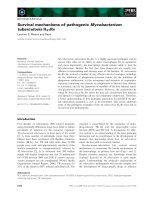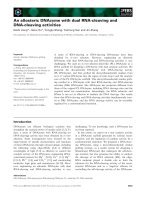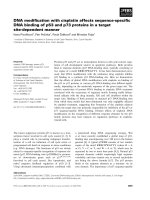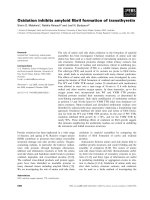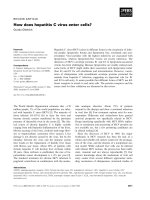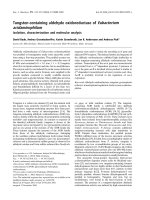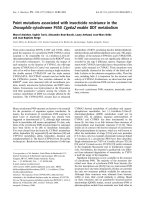Tài liệu Báo cáo khoa học: "Discriminative Word Alignment with Conditional Random Fields" ppt
Bạn đang xem bản rút gọn của tài liệu. Xem và tải ngay bản đầy đủ của tài liệu tại đây (244.67 KB, 8 trang )
Proceedings of the 21st International Conference on Computational Linguistics and 44th Annual Meeting of the ACL, pages 65–72,
Sydney, July 2006.
c
2006 Association for Computational Linguistics
Discriminative Word Alignment with Conditional Random Fields
Phil Blunsom and Trevor Cohn
Department of Software Engineering and Computer Science
University of Melbourne
{pcbl,tacohn}@csse.unimelb.edu.au
Abstract
In this paper we present a novel approach
for inducing word alignments from sen-
tence aligned data. We use a Condi-
tional Random Field (CRF), a discrimina-
tive model, which is estimated on a small
supervised training set. The CRF is condi-
tioned on both the source and target texts,
and thus allows for the use of arbitrary
and overlapping features over these data.
Moreover, the CRF has efficient training
and decoding processes which both find
globally optimal solutions.
We apply this alignment model to both
French-English and Romanian-English
language pairs. We show how a large
number of highly predictive features can
be easily incorporated into the CRF, and
demonstrate that even with only a few hun-
dred word-aligned training sentences, our
model improves over the current state-of-
the-art with alignment error rates of 5.29
and 25.8 for the two tasks respectively.
1 Introduction
Modern phrase based statistical machine transla-
tion (SMT) systems usually break the translation
task into two phases. The first phase induces word
alignments over a sentence-aligned bilingual cor-
pus, and the second phase uses statistics over these
predicted word alignments to decode (translate)
novel sentences. This paper deals with the first of
these tasks: word alignment.
Most current SMT systems (Och and Ney,
2004; Koehn et al., 2003) use a generative model
for word alignment such as the freely available
GIZA++ (Och and Ney, 2003), an implementa-
tion of the IBM alignment models (Brown et al.,
1993). These models treat word alignment as a
hidden process, and maximise the probability of
the observed (e, f ) sentence pairs
1
using the ex-
pectation maximisation (EM) algorithm. After the
maximisation process is complete, the word align-
ments are set to maximum posterior predictions of
the model.
While GIZA++ gives good results when trained
on large sentence aligned corpora, its generative
models have a number of limitations. Firstly,
they impose strong independence assumptions be-
tween features, making it very difficult to incor-
porate non-independent features over the sentence
pairs. For instance, as well as detecting that a
source word is aligned to a given target word,
we would also like to encode syntactic and lexi-
cal features of the word pair, such as their parts-
of-speech, affixes, lemmas, etc. Features such as
these would allow for more effective use of sparse
data and result in a model which is more robust
in the presence of unseen words. Adding these
non-independent features to a generative model
requires that the features’ inter-dependence be
modelled explicitly, which often complicates the
model (eg. Toutanova et al. (2002)). Secondly, the
later IBM models, such as Model 4, have to re-
sort to heuristic search techniques to approximate
forward-backward and Viterbi inference, which
sacrifice optimality for tractability.
This paper presents an alternative discrimina-
tive method for word alignment. We use a condi-
tional random field (CRF) sequence model, which
allows for globally optimal training and decod-
ing (Lafferty et al., 2001). The inference algo-
1
We adopt the standard notation of e and f to denote the
target (English) and source (foreign) sentences, respectively.
65
rithms are tractable and efficient, thereby avoid-
ing the need for heuristics. The CRF is condi-
tioned on both the source and target sentences,
and therefore supports large sets of diverse and
overlapping features. Furthermore, the model al-
lows regularisation using a prior over the parame-
ters, a very effective and simple method for limit-
ing over-fitting. We use a similar graphical struc-
ture to the directed hidden Markov model (HMM)
from GIZA++ (Och and Ney, 2003). This mod-
els one-to-many alignments, where each target
word is aligned with zero or more source words.
Many-to-many alignments are recoverable using
the standard techniques for superimposing pre-
dicted alignments in both translation directions.
The paper is structured as follows. Section
2 presents CRFs for word alignment, describing
their form and their inference techniques. The
features of our model are presented in Section 3,
and experimental results for word aligning both
French-English and Romanian-English sentences
are given in Section 4. Section 5 presents related
work, and we describe future work in Section 6.
Finally, we conclude in Section 7.
2 Conditional random fields
CRFs are undirected graphical models which de-
fine a conditional distribution over a label se-
quence given an observation sequence. We use
a CRF to model many-to-one word alignments,
where each source word is aligned with zero or
one target words, and therefore each target word
can be aligned with many source words. Each
source word is labelled with the index of its
aligned target, or the special value null, denot-
ing no alignment. An example word alignment
is shown in Figure 1, where the hollow squares
and circles indicate the correct alignments. In this
example the French words une and autre would
both be assigned the index 24 – for the English
word another – when French is the source lan-
guage. When the source language is English, an-
other could be assigned either index 25 or 26; in
these ambiguous situations we take the first index.
The joint probability density of the alignment,
a (a vector of target indices), conditioned on the
source and target sentences, e and f , is given by:
p
Λ
(a|e, f ) =
exp
t
k
λ
k
h
k
(t, a
t−1
, a
t
, e, f )
Z
Λ
(e, f )
(1)
where we make a first order Markov assumption
they
are
constrained
by
limits
which
are
imposed
in
order
to
ensure
that
the
freedom
of
one
person
does
not
violate
that
of
another
.
.
autre
une
de
celle
sur
pas
empiète
ne
personne
une
de
liberté
la
que
garantir
pour
fixées
été
ont
qui
limites
certaines
par
restreints
sont
ils
Figure 1. A word-aligned example from the Canadian
Hansards test set. Hollow squares represent gold stan-
dard sure alignments, circles are gold possible align-
ments, and filled squares are predicted alignments.
over the alignment sequence. Here t ranges over
the indices of the source sentence (f ), k ranges
over the model’s features, and Λ = {λ
k
} are the
model parameters (weights for their correspond-
ing features). The feature functions h
k
are pre-
defined real-valued functions over the source and
target sentences coupled with the alignment labels
over adjacent times (source sentence locations),
t. These feature functions are unconstrained, and
may represent overlapping and non-independent
features of the data. The distribution is globally
normalised by the partition function, Z
Λ
(e, f ),
which sums out the numerator in (1) for every pos-
sible alignment:
Z
Λ
(e, f ) =
a
exp
t
k
λ
k
h
k
(t, a
t−1
, a
t
, e, f )
We use a linear chain CRF, which is encoded in
the feature functions of (1).
The parameters of the CRF are usually esti-
mated from a fully observed training sample (word
aligned), by maximising the likelihood of these
data. I.e. Λ
ML
= arg max
Λ
p
Λ
(D), where D =
{(a, e, f )} are the training data. Because max-
imum likelihood estimators for log-linear mod-
els have a tendency to overfit the training sam-
ple (Chen and Rosenfeld, 1999), we define a prior
distribution over the model parameters and de-
rive a maximum a posteriori (MAP) estimate,
Λ
MAP
= arg max
Λ
p
Λ
(D)p(Λ). We use a zero-
mean Gaussian prior, with the probability density
function p
0
(λ
k
) ∝ exp
−
λ
2
k
2σ
2
k
. This yields a
log-likelihood objective function of:
L =
(a,e,f )∈D
log p
Λ
(a|e, f ) +
k
log p
0
(λ
k
)
66
=
(a,e,f )∈D
t
k
λ
k
h
k
(t, a
t−1
, a
t
, e, f )
− log Z
Λ
(e, f ) −
k
λ
2
k
2σ
2
k
+ const. (2)
In order to train the model, we maximize (2).
While the log-likelihood cannot be maximised for
the parameters, Λ, in closed form, it is a con-
vex function, and thus we resort to numerical op-
timisation to find the globally optimal parame-
ters. We use L-BFGS, an iterative quasi-Newton
optimisation method, which performs well for
training log-linear models (Malouf, 2002; Sha
and Pereira, 2003). Each L-BFGS iteration re-
quires the objective value and its gradient with
respect to the model parameters. These are cal-
culated using forward-backward inference, which
yields the partition function, Z
Λ
(e, f ), required
for the log-likelihood, and the pair-wise marginals,
p
Λ
(a
t−1
, a
t
|e, f ), required for its derivatives.
The Viterbi algorithm is used to find the maxi-
mum posterior probability alignment for test sen-
tences, a
∗
= arg max
a
p
Λ
(a|e, f ). Both the
forward-backward and Viterbi algorithm are dy-
namic programs which make use of the Markov
assumption to calculate efficiently the exact
marginal distributions.
3 The alignment model
Before we can apply our CRF alignment model,
we must first specify the feature set – the func-
tions h
k
in (1). Typically CRFs use binary indica-
tor functions as features; these functions are only
active when the observations meet some criteria
and the label a
t
(or label pair, (a
t−1
, a
t
)) matches
a pre-specified label (pair). However, in our model
the labellings are word indices in the target sen-
tence and cannot be compared readily to labellings
at other sites in the same sentence, or in other sen-
tences with a different length. Such naive features
would only be active for one labelling, therefore
this model would suffer from serious sparse data
problems.
We instead define features which are functions
of the source-target word match implied by a la-
belling, rather than the labelling itself. For exam-
ple, from the sentence in Figure 1 for the labelling
of f
24
= de with a
24
= 16 (for e
16
= of) we
might detect the following feature:
h(t, a
t−1
, a
t
, f , e) =
1, if e
a
t
= ‘of’ ∧ f
t
= ‘de’
0, otherwise
Note that it is the target word indexed by a
t
, rather
than the index itself, which determines whether
the feature is active, and thus the sparsity of the
index label set is not an issue.
3.1 Features
One of the main advantages of using a conditional
model is the ability to explore a diverse range of
features engineered for a specific task. In our
CRF model we employ two main types of features:
those defined on a candidate aligned pair of words;
and Markov features defined on the alignment se-
quence predicted by the model.
Dice and Model 1 As we have access to only a
small amount of word aligned data we wish to be
able to incorporate information about word associ-
ation from any sentence aligned data available. A
common measure of word association is the Dice
coefficient (Dice, 1945):
Dice(e, f) =
2 × C
EF
(e, f)
C
E
(e) + C
F
(e)
where C
E
and C
F
are counts of the occurrences
of the words e and f in the corpus, while C
EF
is
their co-occurrence count. We treat these Dice val-
ues as translation scores: a high (low) value inci-
dates that the word pair is a good (poor) candidate
translation.
However, the Dice score often over-estimates
the association between common words. For in-
stance, the words the and of both score highly
when combined with either le or de, simply be-
cause these common words frequently co-occur.
The GIZA++ models can be used to provide better
translation scores, as they enforce competition for
alignment beween the words. For this reason, we
used the translation probability distribution from
Model 1 in addition to the DICE scores. Model 1
is a simple position independent model which can
be trained quickly and is often used to bootstrap
parameters for more complex models. It models
the conditional probability distribution:
p(f , a|e) =
p(|f |||e|)
(|e| + 1)
|f |
×
|f |
t=1
p(f
t
|e
a
t
)
where p(f |e) are the word translation probabili-
ties.
We use both the Dice value and the Model 1
translation probability as real-valued features for
each candidate pair, as well as a normalised score
67
over all possible candidate alignments for each tar-
get word. We derive a feature from both the Dice
and Model 1 translation scores to allow compe-
tition between sources words for a particular tar-
get alignment. This feature indicates whether a
given alignment has the highest translation score
of all the candidate alignments for a given tar-
get word. For the example in Figure 1, the words
la, de and une all receive a high translation score
when paired with the. To discourage all of these
French words from aligning with the, the best of
these (la) is flagged as the best candidate. This al-
lows for competition between source words which
would otherwise not occur.
Orthographic features Features based on
string overlap allow our model to recognise
cognates and orthographically similar translation
pairs, which are particularly common between
European languages. Here we employ a number
of string matching features inspired by similar
features in Taskar et al. (2005). We use an indica-
tor feature for every possible source-target word
pair in the training data. In addition, we include
indicator features for an exact string match, both
with and without vowels, and the edit-distance
between the source and target words as a real-
valued feature. We also used indicator features to
test for matching prefixes and suffixes of length
three. As stated earlier, the Dice translation
score often erroneously rewards alignments with
common words. In order to address this problem,
we include the absolute difference in word length
as a real-valued feature and an indicator feature
testing whether both words are shorter than 4
characters. Together these features allow the
model to disprefer alignments between words
with very different lengths – i.e. aligning rare
(long) words with frequent (short) determiners,
verbs etc.
POS tags Part-of-speech tags are an effective
method for addressing the sparsity of the lexi-
cal features. Observe in Figure 2 that the noun-
adjective pair Canadian experts aligns with the
adjective-noun pair sp
´
ecialistes canadiens: the
alignment exactly matches the parts-of-speech.
Access to the words’ POS tags will allow simple
modelling of such effects. POS can also be useful
for less closely related language pairs, such as En-
glish and Japanese where English determiners are
never aligned; nor are Japanese case markers.
For our French-English language pair we POS
tagged the source and target sentences with Tree-
Tagger.
2
We created indicator features over the
POS tags of each candidate source and target word
pair, as well as over the source word and target
POS (and vice-versa). As we didn’t have access to
a Romanian POS tagger, these features were not
used for the Romanian-English language pair.
Bilingual dictionary Dictionaries are another
source of information for word alignment. We
use a single indicator feature which detects when
the source and target words appear in an entry of
the dictionary. For the English-French dictionary
we used FreeDict,
3
which contains 8,799 English
words. For Romanian-English we used a dictio-
nary compiled by Rada Mihalcea,
4
which contains
approximately 38,000 entries.
Markov features Features defined over adja-
cent aligment labels allow our model to reflect the
tendency for monotonic alignments between Eu-
ropean languages. We define a real-valued align-
ment index jump width feature:
jump
width(t − 1, t) = abs(a
t
− a
t−1
− 1)
this feature has a value of 0 if the alignment labels
follow the downward sloping diagonal, and is pos-
itive otherwise. This differs from the GIZA++ hid-
den Markov model which has individual parame-
ters for each different jump width (Och and Ney,
2003; Vogel et al., 1996): we found a single fea-
ture (and thus parameter) to be more effective.
We also defined three indicator features over
null transitions to allow the modelling of the prob-
ability of transition between, to and from null la-
bels.
Relative sentence postion A feature for the
absolute difference in relative sentence position
(abs(
a
t
|e|
−
t
|f |
)) allows the model to learn a pref-
erence for aligning words close to the alignment
matrix diagonal. We also included two conjunc-
tion features for the relative sentence position mul-
tiplied by the Dice and Model 1 translation scores.
Null We use a number of variants on the above
features for alignments between a source word and
the null target. The maximum translation score
between the source and one of the target words
2
/>3
4
/>68
model precision recall f-score AER
Model 4 refined 87.4 95.1 91.1 9.81
Model 4 intersection 97.9 86.0 91.6 7.42
French → English 96.7 85.0 90.5 9.21
English → French 97.3 83.0 89.6 10.01
intersection 98.7 78.6 87.5 12.02
refined 95.7 89.2 92.3 7.37
Table 1. Results on the Hansard data using all features
model precision recall f-score AER
Model 4 refined 80.49 64.10 71,37 28.63
Model 4 intersected 95.94 53.56 68.74 31.26
Romanian → English 82.9 61.3 70.5 29.53
English → Romanian 82.8 60.6 70.0 29.98
intersection 94.4 52.5 67.5 32.45
refined 77.1 68.5 72.6 27.41
Table 2. Results on the Romanian data using all fea-
tures
is used as a feature to represent whether there is
a strong alignment candidate. The sum of these
scores is also used as a feature. Each source word
and POS tag pair are used as indicator features
which allow the model to learn particular words
of tags which tend to commonly (or rarely) align.
3.2 Symmetrisation
In order to produce many-to-many alignments we
combine the outputs of two models, one for each
translation direction. We use the refined method
from Och and Ney (2003) which starts from the
intersection of the two models’ predictions and
‘grows’ the predicted alignments to neighbouring
alignments which only appear in the output of one
of the models.
4 Experiments
We have applied our model to two publicly avail-
able word aligned corpora. The first is the
English-French Hansards corpus, which consists
of 1.1 million aligned sentences and 484 word-
aligned sentences. This data set was used for
the 2003 NAACL shared task (Mihalcea and Ped-
ersen, 2003), where the word-aligned sentences
were split into a 37 sentence trial set and a 447 sen-
tence testing set. Unlike the unsupervised entrants
in the 2003 task, we require word-aligned training
data, and therefore must cannibalise the test set for
this purpose. We follow Taskar et al. (2005) by us-
ing the first 100 test sentences for training and the
remaining 347 for testing. This means that our re-
sults should not be directly compared to those en-
trants, other than in an approximate manner. We
used the original 37 sentence trial set for feature
engineering and for fitting a Gaussian prior.
The word aligned data are annotated with both
sure (S) and possible (P ) alignments (S ⊆ P ; Och
and Ney (2003)), where the possible alignments
indicate ambiguous or idiomatic alignments. We
measure the performance of our model using
alignment error rate (AER), which is defined as:
AER(A, S, P ) = 1 −
|A ∩ S| + |A ∩ P |
|A| + |S|
where A is the set of predicted alignments.
The second data set is the Romanian-English
parallel corpus from the 2005 ACL shared task
(Martin et al., 2005). This consists of approxi-
mately 50,000 aligned sentences and 448 word-
aligned sentences, which are split into a 248 sen-
tence trial set and a 200 sentence test set. We
used these as our training and test sets, respec-
tively. For parameter tuning, we used the 17 sen-
tence trial set from the Romanian-English corpus
in the 2003 NAACL task (Mihalcea and Pedersen,
2003). For this task we have used the same test
data as the competition entrants, and therefore can
directly compare our results. The word alignments
in this corpus were only annotated with sure (S)
alignments, and therefore the AER is equivalent
to the F
1
score. In the shared task it was found
that models which were trained on only the first
four letters of each word obtained superior results
to those using the full words (Martin et al., 2005).
We observed the same result with our model on
the trial set and thus have only used the first four
letters when training the Dice and Model 1 trans-
lation probabilities.
Tables 1 and 2 show the results when all feature
types are employed on both language pairs. We re-
port the results for both translation directions and
when combined using the refined and intersection
methods. The Model 4 results are from GIZA++
with the default parameters and the training data
lowercased. For Romanian, Model 4 was trained
using the first four letters of each word.
The Romanian results are close to the best re-
ported result of 26.10 from the ACL shared task
(Martin et al., 2005). This result was from a sys-
tem based on Model 4 plus additional parameters
such as a dictionary. The standard Model 4 imple-
mentation in the shared task achieved a result of
31.65, while when only the first 4 letters of each
word were used it achieved 28.80.
5
5
These results differ slightly our Model 4 results reported
in Table 2.
69
(
ii
)
(
a
)
Three
vehicles
will
be
used
by
six
Canadian
experts
related
to
the
provision
of
technical
assistance
.
.
technique
aide
de
prestation
la
de
cadre
le
dans
canadiens
spécialistes
6
par
utilisés
seront
véhicules
3
)
a
)
ii
(
(a) With Markov features
(
ii
)
(
a
)
Three
vehicles
will
be
used
by
six
Canadian
experts
related
to
the
provision
of
technical
assistance
.
.
technique
aide
de
prestation
la
de
cadre
le
dans
canadiens
spécialistes
6
par
utilisés
seront
véhicules
3
)
a
)
ii
(
(b) Without Markov features
Figure 2. An example from the Hansard test set, showing the effect of the Markov features.
Table 3 shows the effect of removing each of the
feature types in turn from the full model. The most
useful features are the Dice and Model 1 values
which allow the model to incorporate translation
probabilities from the large sentence aligned cor-
pora. This is to be expected as the amount of word
aligned data are extremely small, and therefore the
model can only estimate translation probabilities
for only a fraction of the lexicon. We would expect
the dependence on sentence aligned data to de-
crease as more word aligned data becomes avail-
able.
The effect of removing the Markov features can
be seen from comparing Figures 2 (a) and (b). The
model has learnt to prefer alignments that follow
the diagonal, thus alignments such as 3 ↔ three
and prestation ↔ provision are found, and miss-
alignments such as de ↔ of, which lie well off the
diagonal, are avoided.
The differing utility of the alignment word pair
feature between the two tasks is probably a result
of the different proportions of word- to sentence-
aligned data. For the French data, where a very
large lexicon can be estimated from the million
sentence alignments, the sparse word pairs learnt
on the word aligned sentences appear to lead to
overfitting. In contrast, for Romanian, where more
word alignments are used to learn the translation
pair features and much less sentence aligned data
are available, these features have a significant im-
pact on the model. Suprisingly the orthographic
features actually worsen the performance in the
tasks (incidentally, these features help the trial
set). Our explanation is that the other features
(eg. Model 1) already adequately model these cor-
respondences, and therefore the orthographic fea-
feature group Rom ↔ Eng Fre ↔ Eng
ALL 27.41 7.37
–orthographic 27.30 7.25
–Dice 27.68 7.73
–dictionary 27.72 7.21
–sentence position 28.30 8.01
–POS – 8.19
–Model 1 28.62 8.45
–alignment word pair 32.41 7.20
–Markov 32.75 12.44
–Dice & –Model 1 35.43 14.10
Table 3. The resulting AERs after removing individual
groups of features from the full model.
tures do not add much additional modelling power.
We expect that with further careful feature engi-
neering, and a larger trial set, these orthographic
features could be much improved.
The Romanian-English language pair appears
to offer a more difficult modelling problem than
the French-English pair. With both the transla-
tion score features (Dice and Model 1) removed
– the sentence aligned data are not used – the
AER of the Romanian is more than twice that of
the French, despite employing more word aligned
data. This could be caused by the lack of possi-
ble (P) alignment markup in the Romanian data,
which provide a boost in AER on the French data
set, rewarding what would otherwise be consid-
ered errors. Interestingly, without any features
derived from the sentence aligned corpus, our
model achieves performance equivalent to Model
3 trained on the full corpus (Och and Ney, 2003).
This is a particularly strong result, indicating that
this method is ideal for data-impoverished align-
ment tasks.
70
4.1 Training with possible alignments
Up to this point our Hansards model has been
trained using only the sure (S) alignments. As
the data set contains many possible (P) alignments,
we would like to use these to improve our model.
Most of the possible alignments flag blocks of
ambiguous or idiomatic (or just difficult) phrase
level alignments. These many-to-many align-
ments cannot be modelled with our many-to-one
setup. However, a number of possibles flag one-
to-one or many-to-one aligments: for this experi-
ment we used these possibles in training to inves-
tigate their effect on recall. Using these additional
alignments our refined precision decreased from
95.7 to 93.5, while recall increased from 89.2 to
92.4. This resulted in an overall decrease in AER
to 6.99. We found no benefit from using many-to-
many possible alignments as they added a signifi-
cant amount of noise to the data.
4.2 Model 4 as a feature
Previous work (Taskar et al., 2005) has demon-
strated that by including the output of Model 4 as
a feature, it is possible to achieve a significant de-
crease in AER. We trained Model 4 in both direc-
tions on the two language pairs. We added two
indicator features (one for each direction) to our
CRF which were active if a given word pair were
aligned in the Model 4 output. Table 4 displays
the results on both language pairs when these ad-
ditional features are used with the refined model.
This produces a large increase in performance, and
when including the possibles, produces AERs of
5.29 and 25.8, both well below that of Model 4
alone (shown in Tables 1 and 2).
4.3 Cross-validation
Using 10-fold cross-validation we are able to gen-
erate results on the whole of the Hansards test data
which are comparable to previously published re-
sults. As the sentences in the test set were ran-
domly chosen from the training corpus we can ex-
pect cross-validation to give an unbiased estimate
of generalisation performance. These results are
displayed in Table 5, using the possible (P) align-
ments for training. As the training set for each fold
is roughly four times as big previous training set,
we see a small improvement in AER.
The final results of 6.47 and 5.19 with and
without Model 4 features both exceed the perfor-
mance of Model 4 alone. However the unsuper-
model precision recall f-score AER
Rom ↔ Eng 79.0 70.0 74.2 25.8
Fre ↔ Eng 97.9 90.8 94.2 5.49
Fre ↔ Eng (P) 95.5 93.7 94.6 5.29
Table 4. Results using features from Model 4 bi-
directional alignments, training with and without the
possible (P) alignments.
model precision recall f-score AER
Fre ↔ Eng 94.6 92.2 93.4 6.47
Fre ↔ Eng (Model 4) 96.1 93.3 94.7 5.19
Table 5. 10-fold cross-validation results, with and with-
out Model 4 features.
vised Model 4 did not have access to the word-
alignments in our training set. Callison-Burch et
al. (2004) demonstrated that the GIZA++ mod-
els could be trained in a semi-supervised manner,
leading to a slight decrease in error. To our knowl-
edge, our AER of 5.19 is the best reported result,
generative or discriminative, on this data set.
5 Related work
Recently, a number of discriminative word align-
ment models have been proposed, however these
early models are typically very complicated with
many proposing intractable problems which re-
quire heuristics for approximate inference (Liu et
al., 2005; Moore, 2005).
An exception is Taskar et al. (2005) who pre-
sented a word matching model for discriminative
alignment which they they were able to solve opti-
mally. However, their model is limited to only pro-
viding one-to-one alignments. Also, no features
were defined on label sequences, which reduced
the model’s ability to capture the strong monotonic
relationships present between European language
pairs. On the French-English Hansards task, using
the same training/testing setup as our work, they
achieve an AER of 5.4 with Model 4 features, and
10.7 without (compared to 5.29 and 6.99 for our
CRF). One of the strengths of the CRF MAP es-
timation is the powerful smoothing offered by the
prior, which allows us to avoid heuristics such as
early stopping and hand weighted loss-functions
that were needed for the maximum-margin model.
Liu et al. (2005) used a conditional log-linear
model with similar features to those we have em-
ployed. They formulated a global model, without
making a Markovian assumption, leading to the
need for a sub-optimal heuristic search strategies.
Ittycheriah and Roukos (2005) trained a dis-
71
criminative model on a corpus of ten thousand
word aligned Arabic-English sentence pairs that
outperformed a GIZA++ baseline. As with other
approaches, they proposed a model which didn’t
allow a tractably optimal solution and thus had to
resort to a heuristic beam search. They employed
a log-linear model to learn the observation proba-
bilities, while using a fixed transition distribution.
Our CRF model allows both the observation and
transition components of the model to be jointly
optimised from the corpus.
6 Further work
The results presented in this paper were evaluated
in terms of AER. While a low AER can be ex-
pected to improve end-to-end translation quality,
this is may not necessarily be the case. There-
fore, we plan to assess how the recall and preci-
sion characteristics of our model affect translation
quality. The tradeoff between recall and precision
may affect the quality and number of phrases ex-
tracted for a phrase translation table.
7 Conclusion
We have presented a novel approach for induc-
ing word alignments from sentence aligned data.
We showed how conditional random fields could
be used for word alignment. These models al-
low for the use of arbitrary and overlapping fea-
tures over the source and target sentences, making
the most of small supervised training sets. More-
over, we showed how the CRF’s inference and es-
timation methods allowed for efficient processing
without sacrificing optimality, improving on pre-
vious heuristic based approaches.
On both French-English and Romanian-English
we showed that many highly predictive features
can be easily incorporated into the CRF, and
demonstrated that with only a few hundred word-
aligned training sentences, our model outperforms
the generative Model 4 baseline. When no features
are extracted from the sentence aligned corpus our
model still achieves a low error rate. Furthermore,
when we employ features derived from Model 4
alignments our CRF model achieves the highest
reported results on both data sets.
Acknowledgements
Special thanks to Miles Osborne, Steven Bird,
Timothy Baldwin and the anonymous reviewers
for their feedback and insightful comments.
References
P. F. Brown, S. A. Della Pietra, V. J. Della Pietra, and R. L.
Mercer. 1993. The mathematics of statistical machine
translation: Parameter estimation. Computational Lin-
guistics, 19(2):263–311.
C. Callison-Burch, D. Talbot, and M. Osborne. 2004. Statis-
tical machine translation with word- and sentence-aligned
parallel corpora. In Proceedings of ACL, pages 175–182,
Barcelona, Spain, July.
S. Chen and R. Rosenfeld. 1999. A survey of smoothing
techniques for maximum entropy models. IEEE Transac-
tions on Speech and Audio Processing, 8(1):37–50.
L. R. Dice. 1945. Measures of the amount of ecologic asso-
ciation between species. Journal of Ecology, 26:297–302.
A. Ittycheriah and S. Roukos. 2005. A maximum entropy
word aligner for Arabic-English machine translation. In
Proceedings of HLT-EMNLP, pages 89–96, Vancouver,
British Columbia, Canada, October.
P. Koehn, F. J. Och, and D. Marcu. 2003. Statistical phrase-
based translation. In Proceedings of HLT-NAACL, pages
81–88, Edmonton, Alberta.
J. Lafferty, A. McCallum, and F. Pereira. 2001. Conditional
random fields: Probabilistic models for segmenting and
labelling sequence data. In Proceedings of ICML, pages
282–289.
Y. Liu, Q. Liu, and S. Lin. 2005. Log-linear models for word
alignment. In Proceedings of ACL, pages 459–466, Ann
Arbor.
R. Malouf. 2002. A comparison of algorithms for maximum
entropy parameter estimation. In Proceedings of CoNLL,
pages 49–55.
J. Martin, R. Mihalcea, and T. Pedersen. 2005. Word align-
ment for languages with scarce resources. In Proceed-
ings of the ACL Workshop on Building and Using Parallel
Texts, pages 65–74, Ann Arbor, Michigan, June.
R. Mihalcea and T. Pedersen. 2003. An evaluation exer-
cise for word alignment. In Proceedings of HLT-NAACL
2003 Workshop, Building and Using Parrallel Texts: Data
Driven Machine Translation and Beyond, pages 1–6, Ed-
monton, Alberta.
R. C. Moore. 2005. A discriminative framework for bilin-
gual word alignment. In Proceedings of HLT-EMNLP,
pages 81–88, Vancouver, Canada.
F. Och and H. Ney. 2003. A systematic comparison of vari-
ous statistical alignment models. Computational Linguis-
tics, 29(1):19–52.
F. Och and H. Ney. 2004. The alignment template approach
to statistical machine translation. Computational Linguis-
tics, 30(4):417–449.
F. Sha and F. Pereira. 2003. Shallow parsing with con-
ditional random fields. In Proceedings of HLT-NAACL,
pages 213–220.
B. Taskar, S. Lacoste-Julien, and D. Klein. 2005. A discrimi-
native matching approach to word alignment. In Proceed-
ings of HLT-EMNLP, pages 73–80, Vancouver, British
Columbia, Canada, October.
K. Toutanova, H. Tolga Ilhan, and C Manning. 2002. Ex-
tentions to HMM-based statistical word alignment mod-
els. In Proceedings of EMNLP, pages 87–94, Philadel-
phia, July.
S. Vogel, H. Ney, and C. Tillmann. 1996. HMM-based word
alignment in statistical translation. In Proceedings of 16th
Int. Conf. on Computational Linguistics, pages 836–841.
72
